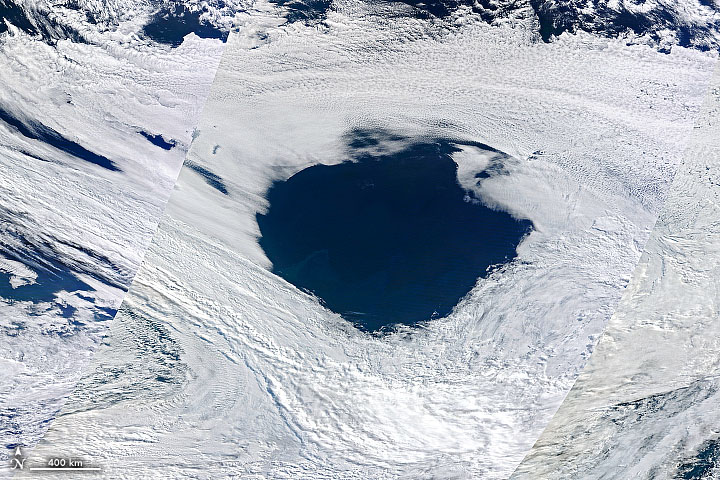
Today’s Image of the Day from NASA Earth Observatory features what appears to be a massive hole in the clouds over the ocean south of the Cape of Good Hope in South Africa. Located between 40 and 60 degrees south of the equator, mariners refer to these turbulent waters as the “Roaring Forties” and “Furious Fifties.”
Gary Partyka is an atmospheric scientist at NASA’s Goddard Space Flight Center. To gain a better understanding of the phenomenon observed in the photograph, he analyzed sea level pressure maps and other data from a NASA weather model called the GEOS Forward Processing system.
“There are actually a few things coming together to make it appear like one connected feature,” said Partyka. “It looks like there was a frontal weather system zipping by from west-to-east between 50-60 degrees south latitude.”
“At the same time, a deck of more stationary, low clouds closer to the tip of Africa was being eroded by a high-pressure region with sinking air.”
“The sinking air produced a semi-circle ring of clouds between 45-50 degrees south. When both of these phenomena lined up in longitude, it gave the appearance of a giant hole in the clouds.”
According to Abdullah Fahad, a NASA atmospheric scientist, winds generally blow outward and away from high-pressure systems, which are typically cooler and denser than surrounding air masses and pull air downward in a spiraling motion.
“This is a really interesting case,” said Fahad. “Keep in mind this is happening in the Southern Hemisphere’s ‘storm tracks’ region, which has regular cyclonic activity, low atmospheric pressures, and high westerly wind speeds most of the time. Seeing a high-pressure system and an anticyclone with the opposite circulation is actually an anomaly for this area.”
“One of the giveaways for me that this isn’t one circular cloud feature is that I can tell that the frontal clouds are at a higher altitude than the deck of low clouds being eroded to the north by looking beyond natural-color imagery,” said Partyka. “MODIS just happened to get a very fortuitous pass when both lined up at the right time.”
The photo was captured on April 3, 2022 by the Moderate Resolution Imaging Spectroradiometer (MODIS) on NASA’s Terra satellite.
Image Credit: NASA Earth Observatory
–—
By Chrissy Sexton, Earth.com Staff Writer






















